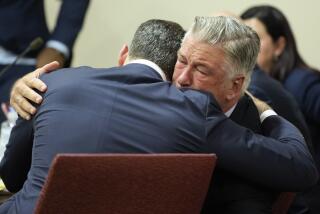Criminal Intent Cuts Off Musician’s Responsibility
- Share via
Chuck Philips does an admirable job in his article portraying the anguish of Linda Sue Davidson at the death of her police officer husband (“Testing the Limits,” Calendar, Oct. 13). But Davidson’s attempt to blame rap artist Tupac Amaru Shakur for the death combines shaky reasoning with a dangerously simplistic view of art.
It is a terrible thing that Davidson’s husband was senselessly killed. But the legal question is, who is responsible for this death? Interestingly, it is not until the fifth paragraph of the article that Philips finally mentions that Bill Davidson was shot by 19-year-old Ronald Ray Howard. Prior to that, a reader might have thought Tupac was Officer Davidson’s killer.
The lawsuit is an attempt to blame a song for the bullet’s path. Since it is almost certain Howard was listening to a tape of Tupac’s album, “2PACAYPSE NOW,” which concededly includes lyrics about killing police officers, Davidson argues those lyrics prompted Howard to act. Therefore, the people responsible for the lyrics should join Howard in being punished for the death.
A law student might be able to pass first-year torts or criminal law advocating such a theory, but only barely. Howard formed his own intent to pull the trigger. The universally recognized rule is that even if Tupac’s lyrics did give Howard the idea, Howard’s intentional criminal act cuts off everyone else’s responsibility. Even if Tupac had an evil intent, it was Howard and only Howard who fired the gun.
Davidson’s attorneys might be able to persuade a jury that Tupac is still civilly responsible because he should have foreseen that someone like Howard would listen to the song and act. That legal theory still has some viability, and might be accepted by the jury in these days when rap music is being blamed for everything but the decline of the Roman Empire. But the logic of this argument is ultimately absurd and its consequences could be devastating.
For example, how far would it go? Philips’ article included relevant lyrics from the album, as this paper does in nearly all of the recent cases where rap lyrics are being challenged. And The Times is certainly aware of the allegations that such lyrics incite subsequent violence. Could a newspaper be held responsible if it were proved that a cop killer was a subscriber? After all, it is the lyrics that are supposed to incite the action. It is not hard to see how this argument is the very recipe for censorship. There is no shortage of dull and literal reasoning in America today. Andre Serrano’s photograph of a crucifix immersed in urine was denounced by some Christians as sacrilege, while the image was understood by many as the artist’s condemnation of those very Christians who sacrilegiously use that great and powerful religious symbol for their own low-grade purposes.
George Bush attacked Bill Clinton for being unpatriotic because Clinton demonstrated against U.S. involvement in Vietnam, when millions who opposed that war felt demonstrating was the most sincere way they could show they cared deeply about a country they perceived was doing so much wrong.
Television shows that include characters who are homosexual are condemned by some because they “advocate” homosexuality regardless of how neutral the presentation is. “Advocacy” loses its meaning if it is defined as no more than presentation of an idea.
This kind of unsophisticated reasoning is dangerous, reducing artists who deal with controversial topics to simplistic propagandists. If Davidson wins her suit, any work that includes violence may be enough to make the artist liable for some subsequent violence in real life. It is this kind of logic that could sanitize our art into an endless stream of Annies. It is sometimes necessary to present violence in order to understand violence, to present sex in order to understand sex, to present hate in order to understand hate.
Art explores our complex, fascinating and sometimes terrifying humanity. Sometimes artists do their job well, sometimes badly. But even the worst art can be distinguished from firing a gun.
Tupac and Howard both carried in them rage against the police. But what they did with their rage makes all the difference. Tupac took his out in a studio, Howard took his out on the streets. When Officer Davidson died, it was not because of a song. If art cannot be an outlet for passionate feelings, we will have no art left.
More to Read
The biggest entertainment stories
Get our big stories about Hollywood, film, television, music, arts, culture and more right in your inbox as soon as they publish.
You may occasionally receive promotional content from the Los Angeles Times.









